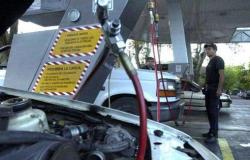
Families living in the Buenos Aires Metropolitan Area (AMBA) needed more than $118,000 in May to pay public service rates, according to a report from the Rates and Subsidies Observatory of the Interdisciplinary Institute of Political Economy (IIEP), which depends from the UBA and Conicet.
The analysis calculated that the basket of public services for an average AMBA home was $118,825, without subsidies, during the fifth month of the year. This cost represents an increase of 15.6% compared to the expense of $102,779 in April.
The increase in the basket, which includes coverage of energy, transportation and drinking water needs, “is mainly explained by higher consumption of natural gas and electricity as the winter seasonal peak approaches,” the report stated. .
The cost of the total basket increased 295% compared to December 2023 due to the updates to transportation rates (January and February), electricity (February), water and natural gas (April).
In the breakdown by service, the work specified that “the most important increase was for natural gas with an increase of 893% compared to December 2023 and is explained both by the increase in rates in April and by a more intensive use in the month of May compared to December” and contributed that “spending on transportation increased 410%, on water 209% and on electricity 124%.”
With these values, in May, the AMBA public services basket occupies 14% of the average salary registered for the month while the most important weight within the services is occupied by transportation spending.
The data are known amid the Government’s decision to postpone the planned increases in gas and electricity rates, and to increase transport subsidies, to help consolidate the decline in inflation in recent weeks.
In this regard, the study revealed that “rate coverage, estimated as the weighted average of the costs of public services in the AMBA at the expense of the user, is 37% in the month of May.” This means that “the State takes charge of the remaining 63%.”
Subsidies
In this sense, the main economic subsidies to the Water, Energy and Transportation sectors had an accumulated annual growth of 133.4% in April compared to the same period of the previous year and therefore their real variation shows a reduction of 40.8% accumulated annually in the period.
In this way, the report once again shows the Government’s cut in subsidies and transfers to service license companies. In that sense, the study revealed that “in the first quarter, an execution of 47% was accumulated with respect to the current credit for the selected items.”
Energy subsidies, which represent 76% of total subsidies, increased by 138% in nominal annual cumulative terms while decreasing by 40.7% in real annual cumulative terms in the first four months.
The transfers accrued from Energía Argentina SA
(ENARSA) accumulated in four months increased 63.9% nominal annual accumulated (-57.4% real annual accumulated). In turn, transfers to CAMMESA increased by 213.6% nominal accumulated annually while they decreased by 23.4% accumulated annually in real terms.
Transfers through the Gas.Ar Plan (incentives for natural gas production) were reduced by 49.1% accumulated annually (-85.9% in real terms). Meanwhile, transfers to Aerolíneas Argentinas were null while AYSA earned only $75 million compared to $7,455 in the same previous period.
The Transportation sector, for its part, explains 24% of transfers and grows 127.9% accumulated annually in nominal terms, which is equivalent to a reduction of 39% in real terms. The Observatory highlighted that “within it, the most relevant item is the Trust Fund for the Transportation Infrastructure System (FFSIT), which grows 159.7% a year in nominal terms and decreases -30.5% a year in real terms in the first quarter of 2024”.
floating debt
The report reflects that “in the first quarter, a contribution to increasing the floating debt of the National State was observed by $356,996 million in nominal terms for the year 2024, explained by accruals above payments mainly from CAMMESA and ENARSA.”
Furthermore, he explains that in said period, “the largest contributor to the floating debt is CAMMESA, which totals $170,000 million and explains 47% of the total debt accumulated in the period.”
With information from agencies.
I.G.





